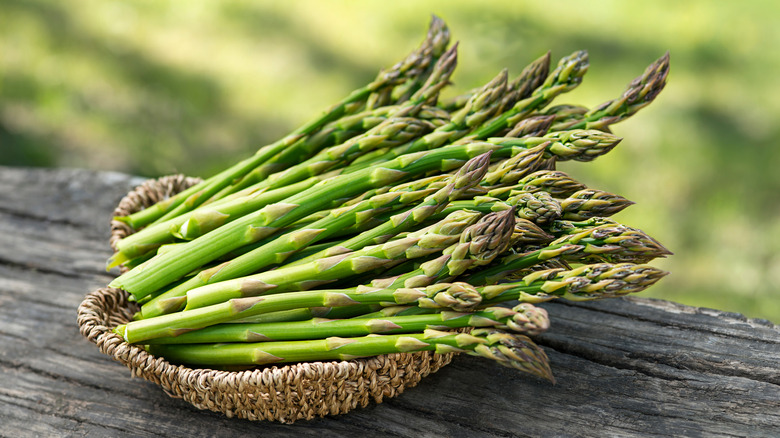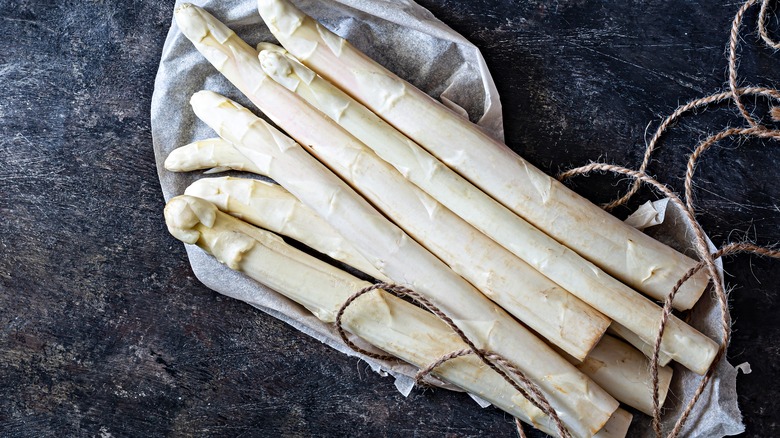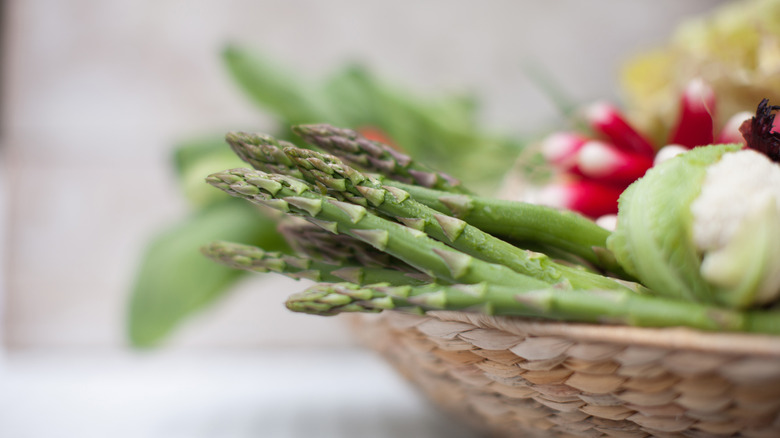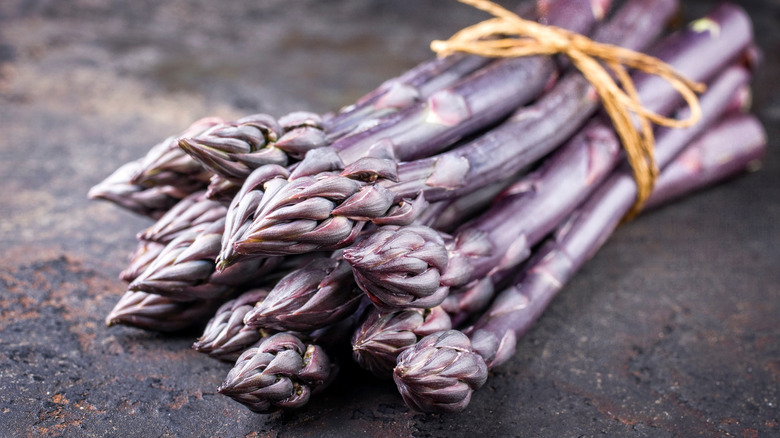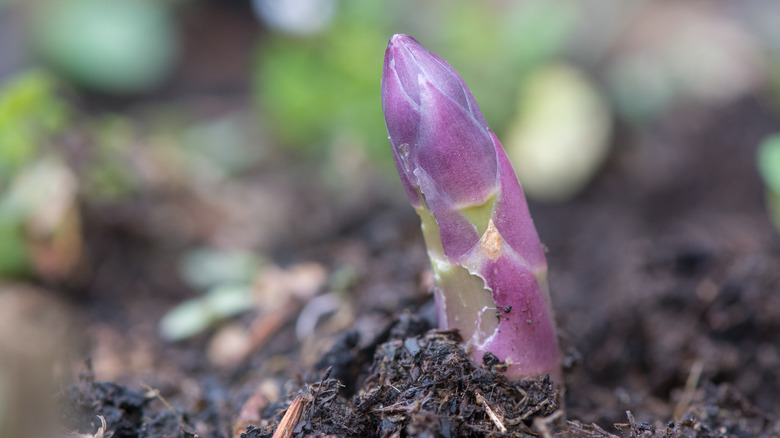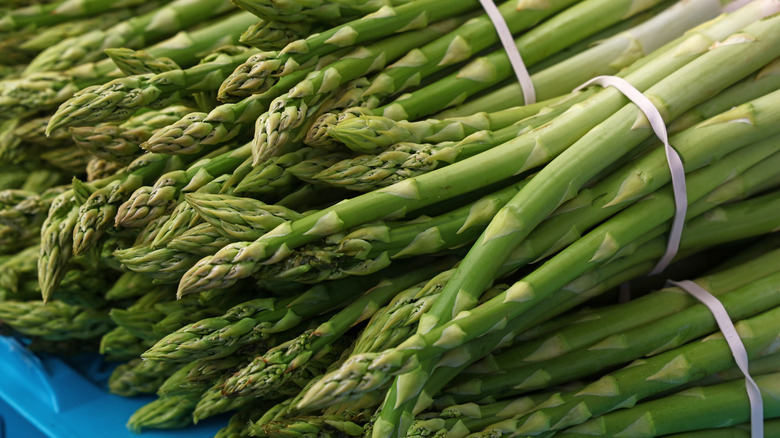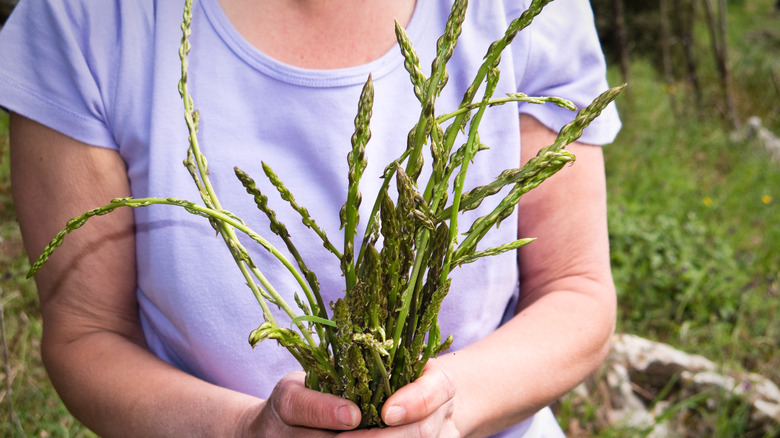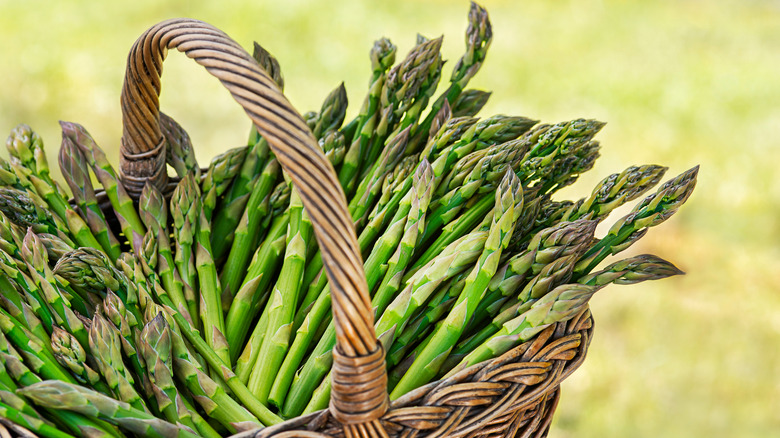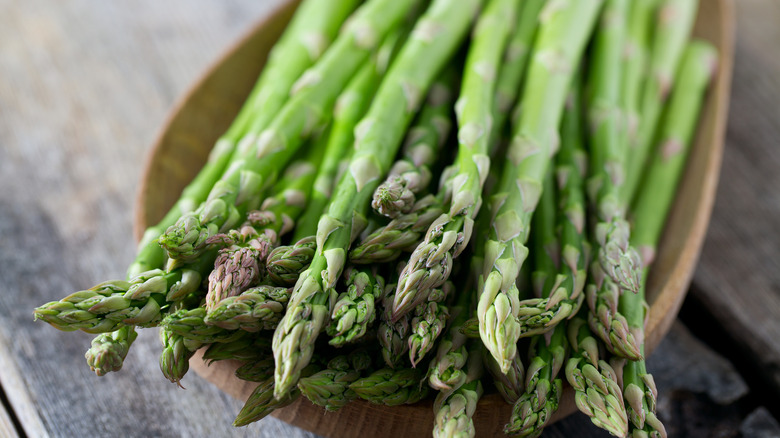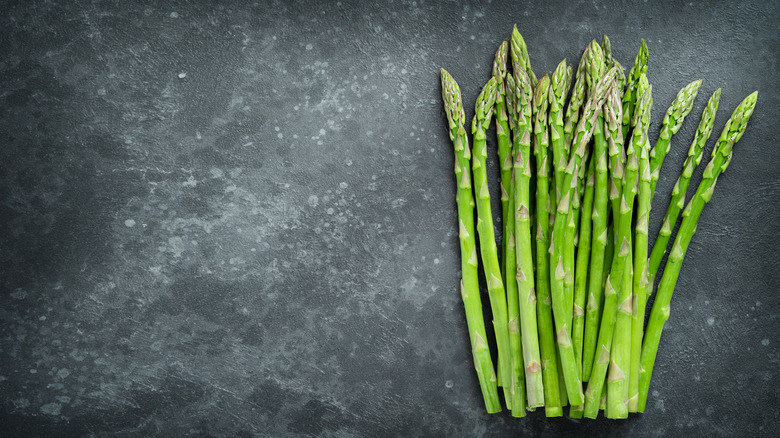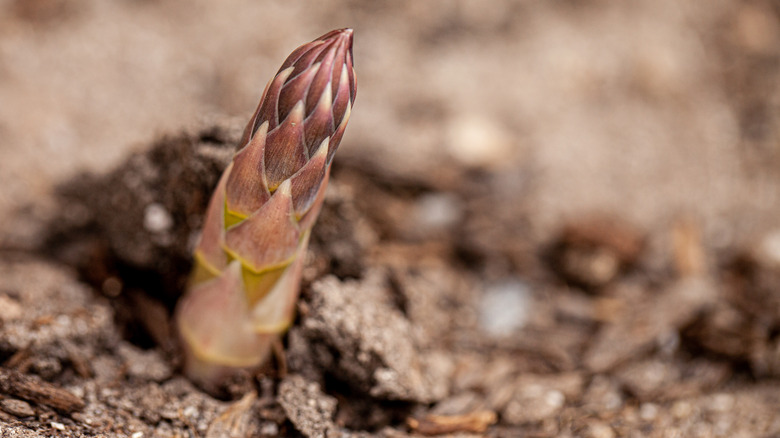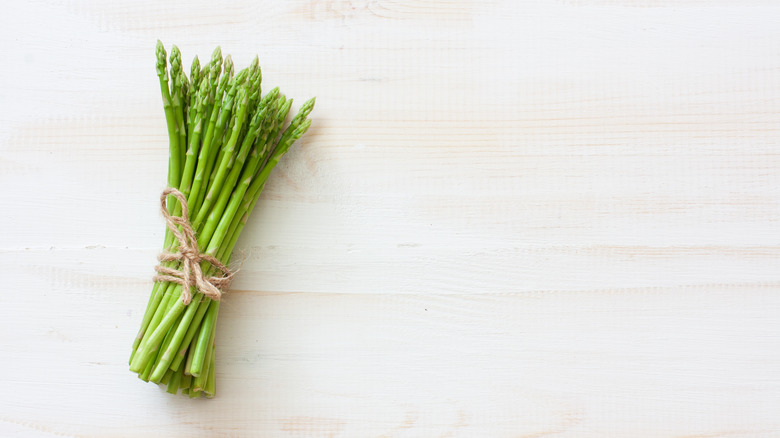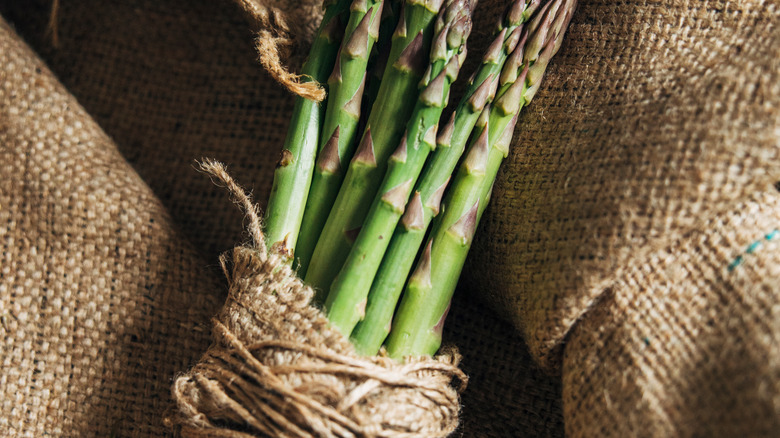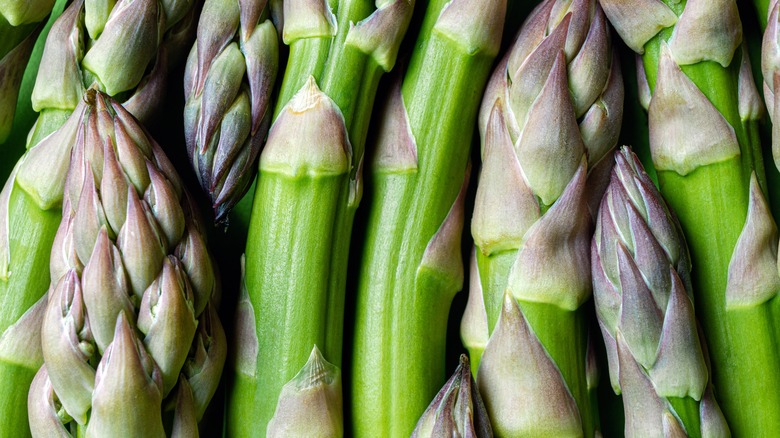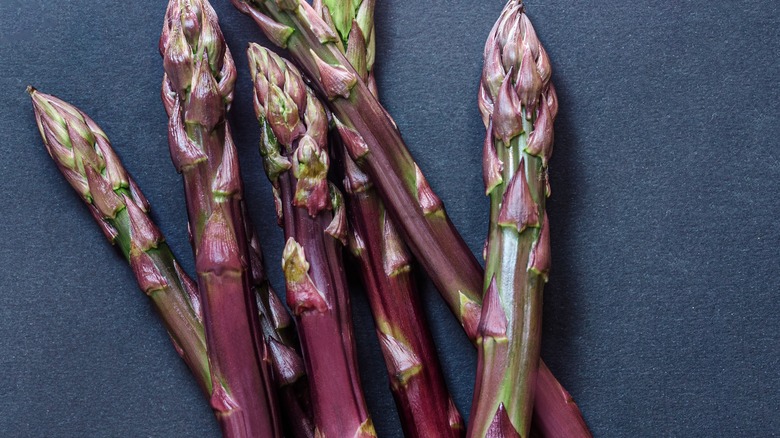14 Types Of Asparagus You Should Get To Know
It's easy to forget how good asparagus is. In a world of abundant food choices, this spear-shaped vegetable can often be pushed to the bottom of the pile and only enjoyed on special occasions. But there's a strong case to be made for getting asparagus into your weekly rotation. An ancient vegetable, asparagus was originally enjoyed way back in historical Egypt and Greece and has stood the test of time to show up in a range of modern recipes. And there's a wonderful versatility to the plant — for example, in fresh seasonal favorites like spring salad with asparagus served with risotto, pasta, or quiche.
Although green asparagus is by far the most recognizable, this vegetable comes in a range of colors, shapes, and sizes. And as different cultivars have sprung up, they've brought with them a diverse range of flavor profiles and culinary uses.
But with so many types, where do you start? Let's dive into all the types of asparagus you should get to know.
White asparagus
If you've only ever known asparagus to be green, prepare to have your world rocked. White asparagus is exactly what it says on the tin: Regular-looking asparagus, but bright white. Despite looking pretty different, these vegetables have the same origins and are in essence the same plant. The difference between green and white asparagus, though, is in how they're grown. Green asparagus is given the full extent of the sun's rays, which develops its chlorophyll and its verdant color. White asparagus, on the other hand, is grown in darkness, which stops it from gaining any color.
Although white asparagus is less common (in many places) than its green sibling, it's particularly popular in some parts of the world, like Germany. The way that white asparagus is grown also alters its flavor, and it has a slightly gentler taste than other asparagus types. Steaming or boiling it will provide you with a tender, mild-tasting accompaniment to your main meal — or you can grill or fry the spears to develop a bit of color on their outsides. White asparagus can be a little tougher than its green counterpart. So, you'll need to take off its exterior layer and remove the bottom of the plant before cooking it.
Jersey Giant
While big doesn't automatically mean better, it never hurts to make your portions of vegetables a little larger. And there's no better way to do that than to get bigger vegetables in the first place. That's where the Jersey Giant comes in, a hybrid asparagus cultivar that produces spears of up to 12 inches. Jersey Giant was developed at Rutgers University and has achieved recognition for its sturdiness and ability to withstand crown rot and rust. What also makes Jersey Giant unique is that you don't need the perfect conditions for it to grow: It'll do well in most climates.
This plant's hardiness, however, also means that it takes a little longer to cook. Jersey Giant can be a bit tougher than other, more tender asparagus varieties, so it's best not used in situations where you may need your asparagus to be softer, like in salads. Instead, the Jersey Giant is a great variety to cook when you're going for roasted asparagus. Roasting it in the oven with a little olive oil, salt, and pepper, will help it brown and soften up considerably. It's also a great choice when asparagus is the star of the dish, thanks to its bigger size.
Purple Passion
Get ready to have your mind blown! Green asparagus is good and all, but what if it was a little more ... purple? Maybe you've never seen purple asparagus, but it's out there — and once you try it, you'll want more! Purple Passion is characterized by its deep purple spears, which can appear almost black at their tips. As with other asparagus types, Purple Passion can grow pretty tall, with some plants reaching 4 feet. And, like different varieties, it'll generally grow without you having to do too much to it.
But what about that all-important taste? Interestingly, while you might assume that its dark color creates an intensity of flavor, these plants are quite mild-tasting and have a sweetness to them. Keep in mind these asparagus won't retain their purple tones in all situations. If you cook Purple Passion, its color changes, turning green. So, to best retain the visual impact of this veggie, serve it raw, either chopped up and placed in a salad, or as part of a crudité platter.
Precoce D'Argenteuil
While asparagus can be found in multiple countries' national cuisines, it's perhaps most associated with French cooking, and it has been grown and cooked in the European nation for several centuries. Out of all the asparagus varieties out there, Precoce D'Argenteuil might be the one most commonly used in France. A staple in French cuisine since the 19th century, this springtime vegetable performs better in cooler temperatures. When it's fully grown, it has a green-purple exterior, with tips that have an easy bite to them.
But when prepared traditionally, Precoce D'Argenteuil doesn't stay purple for long. This asparagus variety is best known for being served blanched until light or white. This makes the plant seriously tender and flavorful, as well as giving it an enviable aesthetic appeal. Precoce D'Argenteuil can be served in all manner of ways, but one of the best uses of it is to add it to a springtime risotto. Add the sliced asparagus toward the end of the cooking process, to avoid it breaking down too much and losing its bite.
Mary Washington
If you like your asparagus with a classic look, the Mary Washington variety is for you. Mary Washington asparagus is well-known for its bright green color and uniform spears, which can grow to about 30 inches high. One of the most appealing things about Mary Washington asparagus is how easy it is to grow. These robust plants can thrive under even the most clumsy gardener's thumb, need little attention once successfully planted, and don't suffer from asparagus rust as other varieties can.
And when asparagus is as bright green and eye-catching as Mary Washington is, you're going to want to show it off. That's why these shoots, which become tender when cooked, are best placed at the center of a meal. Try using them to make baked asparagus with fried egg and dill, by baking them for 12 to 15 minutes in a 400-degree Fahrenheit oven, coating them with oil and seasonings before throwing them in.
Finish the Mary Washington asparagus off under a hot broiler to give them a little extra brown, place them on a plate, and top them with a fried egg and some dill. A minimal-effort meal that allows all of those asparagus flavors to shine.
Wild asparagus
In the modern world, we've become accustomed to being able to pick up any food we want from the store. But sometimes, to get the best flavors, you have to be a little more intrepid. That's why you should be on the hunt for wild asparagus. True to its name, wild asparagus is asparagus that grows outside of a farming setting. While it can often be found in coastal areas where the soil is saltier, you can find wild asparagus in proximity to virtually any water source. You'll find wild asparagus during the spring months before the weather gets too hot.
Wild asparagus looks similar to regular store-bought asparagus, although it can have less of a uniform look. It can sprout in either green or green-purple coloring. Interestingly, wild asparagus can have a stronger flavor than farm-grown asparagus and can be much sweeter. But like regular asparagus, it can be cooked in a range of ways and is especially good when roasted or grilled. It's also worth bearing in mind that while wild asparagus can be super-fun to find and take home, it can also be quite rare, so you should resist the urge to pull every spear you find out of the ground — leave some of it for other people to grab and enjoy.
Apollo
Any plant that's named after an Ancient Greek God will need to live up to its name. And luckily, Apollo asparagus holds its own. Apollo is an especially attractive asparagus variety, with deep green shoots that are flecked with purple, leading to darker green, purple-tinged tips. These plants tend to be pretty simple to grow, requiring only weekly watering and can flourish even in warmer conditions, which other asparagus types can have trouble doing.
Apollo asparagus has a slightly earthy taste, like other green asparagus varieties, and performs well in virtually any recipe that calls for the vegetable. One thing about Apollo which is particularly attractive is the fact that it freezes well. To do so, simply blanch the spears for a few minutes, before putting them in an ice bath. Then, dry them off with paper towel, before collecting them up and putting them into a freezer bag. Remember, however, that Apollo is just as good when cooked and served fresh. Try steaming it gently, then tossing in a little butter, salt, and pepper, for the perfect accompaniment to virtually any meal.
Atlas
Another asparagus that's name has its roots in classical mythology, Atlas is as strong as the figure it's named after. This hardy hybrid is resistant to Fusarium, also known as root rot, as well as standing up well against frost and drought. Atlas tends to grow a little larger than regular asparagus (hey, no complaints from us, that's more vegetable for your buck), and produces a good yield when grown correctly. It also has that textbook, dark green asparagus color, with purple flecks here and there.
The main reason that Atlas merits a place on this list, though, is its flavor. This variety has a particularly deep, earthy taste, with a nutty edge that sets it apart from other, milder varieties. Its pronounced flavor means that it's a superb choice when you want your vegetable to have a little more punch. Try using Atlas in an asparagus and fontina quiche, baked in a pie crust with cheese, eggs, and cream. The slightly grassy flavor to the Atlas will help to cut through and offset the richness of the dairy, balancing the flavors and providing an element of freshness to an otherwise heavy meal.
UC 157
UC 157 variety of asparagus sounds more Star Wars character than vegetable. While its name is a little scientific, the reality is that it's a verdant, delicious asparagus, which has a classic appearance of dark green shoots and detailed crowns. UC 157 is the most commonly-grown asparagus variety worldwide, meaning that if you've enjoyed the vegetable recently, there's a strong likelihood it was this type — not bad for a cultivar that didn't exist before the late 1970s.
UC 157 asparagus is both sweet and nutty and is abundant in vitamins and minerals. It will grow under most circumstances and, as a perennial plant, will continue to give you delicious-tasting veggies year after year. This asparagus is versatile, and whether you're boiling, steaming, blanching, roasting, or broiling it, it'll likely end up delicious. In our opinion, UC 157 is delicious as one of the main elements in a pasta dish, chopped up and tossed with light, fresh flavors like lemon and olive oil.
Jersey Knight
The Jersey asparagus family has a few different types, and true asparagus aficionados will want to try them all. Well, make sure you add Jersey Knight to your list. This hybrid variety flourishes in the spring, and when it grows, it really grows, producing an abundant crop of vegetables. Like many other hybrids, it's been developed to hold its own against diseases, which only makes it even more likely to continue producing asparagus year after year.
Jersey Knight has a standard green appearance for most of its length, tending to turn paler toward its base. While it can have some purple coloring on the outside of its shoots, this tends to be a little less pronounced than other varieties like Apollo or Atlas. It can also have light purple, almost brown tips. Its shoots are usually fairly uniform, making this an attractive plant. As for taste, the Jersey Knight doesn't hold back and has a strong asparagus flavor. To keep this powerful flavor, cook it via more gentle methods, like steaming or blanching. Other heating applications may reduce its taste somewhat.
Viking KB3
So, we're under no illusions that the name "Viking KB3" makes this asparagus sound like it could be a make of office chair. But there's nothing man-made about this plant. Well, aside from the fact that it was intentionally developed in Canada, as an offshoot of the Mary Washington variety, that is. But don't let that stop you from buying this well-cultivated, delicious asparagus.
One of the most striking things about the Viking KB3 is its color, which is a super-vivid green for the majority of its length. Thanks to its cultivation, it's more resistant to weather and disease than Mary Washington and produces way more shoots (and therefore more deliciousness). One useful way to distinguish Viking KB3 from other types is by its girth. While some asparagus types can be fatter and squatter, Viking KB3 is usually around pencil width. This gives this asparagus a certain elegance that other varieties may not have and makes it a fantastic option for your fancier dinner parties, or just to snack on, with a little bit of dip and some salt and pepper.
Jersey Supreme
Perhaps the most extravagantly named of the Jersey asparagus family, Jersey Supreme is a plant worthy of your attention. This asparagus type is a hybrid breed, specially cultivated to produce the best vegetable possible. And all of that cultivation paid off. The Jersey Supreme is notable for its uniform appearance and like other Jersey asparagus is excellent at fighting garden-bound invaders that could diminish its quality.
Jersey Supreme are generally mid-green in appearance, with purple, almost brown flecks running up the length of the plant. They're a strong variety and can have a good thickness to them, with a distinguished flavor that gives you all of that asparagus-y goodness. Nutrient-rich, Jersey Supreme is full of numerous minerals that your body needs regularly, including copper, calcium, potassium, and zinc. They've also got a good amount of fiber, essential for gut health. Just bear in mind that however you prepare your Jersey Supreme, be it roasting, blanching, or pickling, their bases are rather tough, so make sure you remove them before cooking and eating.
Guelph Millenium
This asparagus, originating in North America, is sure to keep you and your guests happy. Guelph Millenium is a relatively new breed and was first developed in Northern Canada, which ensures its ability to thrive in even the toughest of conditions. The Guelph Millenium variety is best harvested toward the end of the spring, and this perennial vegetable, once properly developed, will keep providing tasty veg year in, and year out.
Guelph Millienium is recognizable by its two-tone appearance. The asparagus stalks are green throughout, with the tips of the spears turning purple. Unlike some other asparagus breeds, this one is tender upon harvesting, and you don't need to cook it before consuming it. For best results, enjoy it straight out of the garden or when you get home from the store, by washing, slicing, and scattering the pieces into a salad. If you do want to cook them, though, we'd recommend doing so gently, to retain their tender bite. Try putting them in a bamboo steamer over a pot of simmering water, checking them every few minutes until they're a perfect consistency.
Pacific Purple
Sure, green asparagus is great and all, but it can get a little samey sometimes. So, if you want to jazz up the color of your meal, grab yourself some Pacific Purple. A purple asparagus (which you probably gathered from its name), Pacific Purple grows in a deep violet shade, with punchy green streaks throughout its body. They can grow up to 1.5 meters in height and can vary in thickness, with some slightly narrower and others growing plump and girthy.
While some asparagus can be guilty of becoming a little stringy and fibrous, Pacific Purple doesn't have the same tendencies. These spears remain tender, even when raw. Its purple color is provided by anthocyanins growing in the plant, which are potent antioxidants that give these vegetables an added health factor. Like the other purple varieties out there, Pacific Purple can be sweeter than its green counterparts.
Importantly, however, it won't keep its purple color forever. If you cook Pacific Purple too aggressively, it will lose all of its violet hues. For this reason, it's best to eat Pacific Purple raw or to steam them until just cooked. You don't want to go to all that trouble getting purple asparagus to then not enjoy its color, do you?
